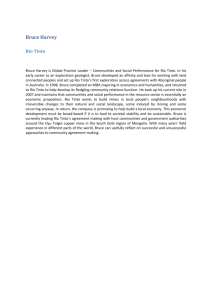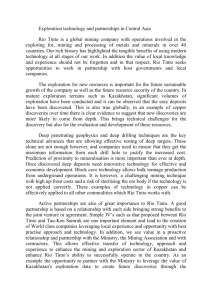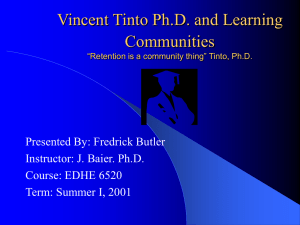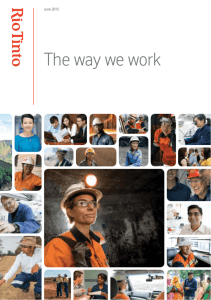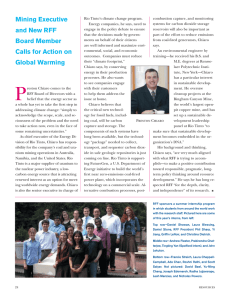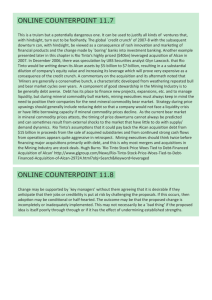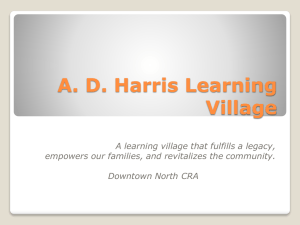T A R Z
advertisement
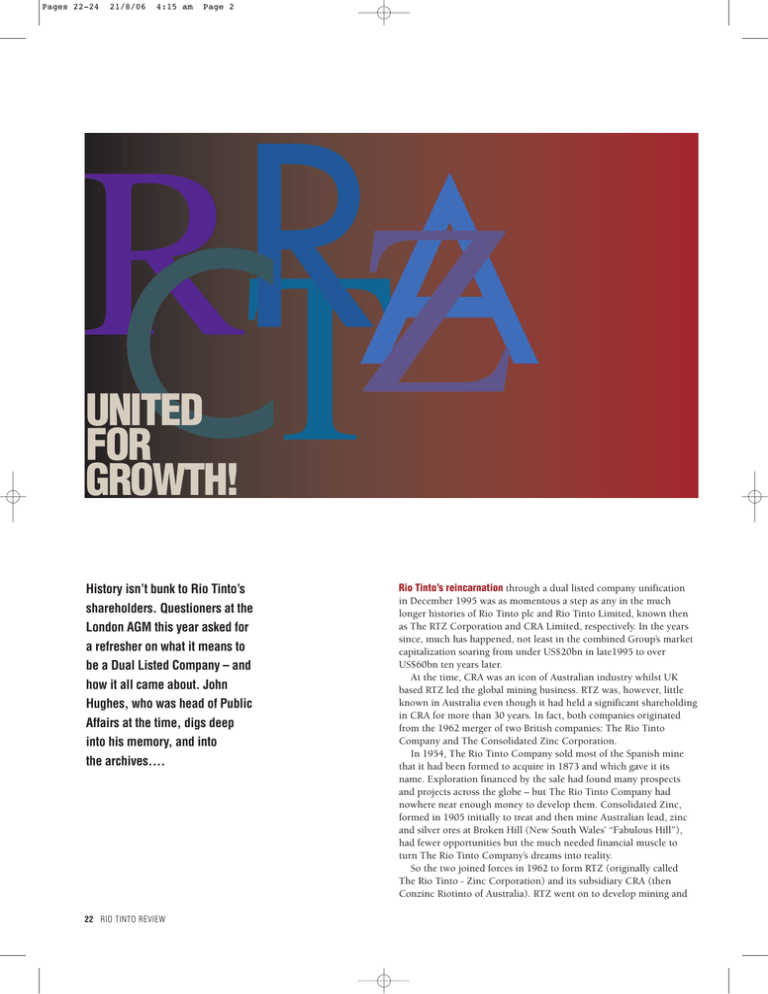
Pages 22-24 21/8/06 4:15 am Page 2 R R A Z CT UNITED FOR GROWTH! History isn’t bunk to Rio Tinto’s shareholders. Questioners at the London AGM this year asked for a refresher on what it means to be a Dual Listed Company – and how it all came about. John Hughes, who was head of Public Affairs at the time, digs deep into his memory, and into the archives…. 22 RIO TINTO REVIEW Rio Tinto’s reincarnation through a dual listed company unification in December 1995 was as momentous a step as any in the much longer histories of Rio Tinto plc and Rio Tinto Limited, known then as The RTZ Corporation and CRA Limited, respectively. In the years since, much has happened, not least in the combined Group’s market capitalization soaring from under US$20bn in late1995 to over US$60bn ten years later. At the time, CRA was an icon of Australian industry whilst UK based RTZ led the global mining business. RTZ was, however, little known in Australia even though it had held a significant shareholding in CRA for more than 30 years. In fact, both companies originated from the 1962 merger of two British companies: The Rio Tinto Company and The Consolidated Zinc Corporation. In 1954, The Rio Tinto Company sold most of the Spanish mine that it had been formed to acquire in 1873 and which gave it its name. Exploration financed by the sale had found many prospects and projects across the globe – but The Rio Tinto Company had nowhere near enough money to develop them. Consolidated Zinc, formed in 1905 initially to treat and then mine Australian lead, zinc and silver ores at Broken Hill (New South Wales’ “Fabulous Hill”), had fewer opportunities but the much needed financial muscle to turn The Rio Tinto Company’s dreams into reality. So the two joined forces in 1962 to form RTZ (originally called The Rio Tinto - Zinc Corporation) and its subsidiary CRA (then Conzinc Riotinto of Australia). RTZ went on to develop mining and “RTZ’s financial and international experience, CRA’s exploration, operating and technology skills and the combined environmental and social competencies of both, would lead to major operating efficiencies. Even more importantly for the longer term, they could take on much more together than either could individually.” other activities across the world while CRA concentrated on Australasia. By 1986, RTZ’s interest in CRA had been reduced progressively by economic, commercial and other considerations to 49 per cent. By agreement, both companies were run independently by their own managements. So it continued until 1995. So why the change? In a word, globalization. Geopolitical upheavals in the late eighties and early nineties saw communism swept away in Europe, the demise of resource nationalism internationally – and vast tracts opened up for mineral exploration across the world. RTZ had refocused solely on its mining and related activities by then, selling non core assets and buying mineral businesses whenever shareholder value could be gained. By 1995, RTZ had emerged as a world leader in mining and among the largest companies in the UK. Its substantial interests, other than those held through CRA, included copper, gold, borates, titanium dioxide feedstock, talc, coal and uranium, predominantly located in the Americas as well as in Europe, southern Africa and Indonesia. Pre 1995, having established major aluminium, copper, coal and iron ore operations, CRA had pursued a strategy of reducing debt and selling non core and unprofitable businesses, concentrating its efforts on “upstream” activities. Although returns improved they were not matched by underlying growth; earnings before interest and tax suffered a declining trend. A strategic review in 1994 confirmed that CRA simply had to increase its asset base to sustain its position. Growth Task Forces quickly identified exploration and acquisition opportunities outside Australia. But those opportunities had also been seen by RTZ. The potential for conflicts of interest with CRA’s largest shareholder were increasing fast. Wouldn’t it make more sense to work together anyway? CRA and RTZ’s complementary portfolios would provide a much stronger worldwide platform for profitable growth. RTZ’s financial and international experience, CRA’s exploration, operating and technology skills and the combined environmental and social competencies of both, would lead to major operating efficiencies. Even more importantly for the longer term, they could take on much more together than either could individually. But how could it best be done? The answer proved far from straightforward. After an initial approach in February 1995 by CRA’s chairman and chief executive to the two non executive directors of CRA representing RTZ, it became clear that for a merger of RTZ and CRA to succeed, it was necessary that it be seen as a true merger of more or less equal partners and that the merger not give rise to unacceptable premiums, massive tax liabilities or significant regulatory hurdles. Of particular concern was the position of the shareholders of the merged companies, including preserving the ability to pay fully franked dividends to CRA’s Australian resident shareholders and avoiding a disposal of the shares of RTZ’s shareholders (which would give rise to a taxable capital gain). Shareholders of both RTZ and CRA had to benefit. By mid year some great minds in the UK and Australia, after reflecting on the corporate structures of Shell and Unilever, each of which was in reality two seperate but inextricably linked companies, came up with the DLC structure. Could this work for RTZ and CRA? The proposed RTZ-CRA DLC structure learned lessons from, built on and went much further than existing Anglo-Dutch models to ensure success. As one Australian commentator put it: “Conceptually, the proposal is very simple and very complex. On one level nothing much changes, yet in fact everything does.” (Terry McCrann, Melbourne Herald Sun, 10 October 1995). The two companies would continue as distinct legal entities, with their own shareholders and annual general meetings, but the directors of both would be the same people. Votes of shareholders in one company would be reflected in meetings of the other so that all shareholders decided matters of common interest together, including the election of directors. Their assets would be run as a whole by one management team. Accounts would be drawn up for the combined group in US dollars, the mining industry’s currency, and the same US dollar dividend would be declared for both companies, but paid in equivalent Australian dollars or sterling to local shareholders. Effectively, RTZ and CRA shareholders would be in exactly the same position as if they held shares in a single, unified enterprise. It took a huge effort to persuade many stakeholders of the DLC merits. Initially, many thought the complexity far too great to be successful; others that one set of shareholders benefited more than the other – or vice versa. Eventually, though, after several cliff hangers, any of which could have spelled disaster, all third parties finally agreed – the last only during the CRA shareholders’ meeting to approve the proposal. After all the effort and months of sleepless nights for executives and external advisers, with 200mm thick wodges of detailed information thudding onto door mats across the world, an overwhelming 98.8 per cent of CRA shareholders supported the unification at their general meeting on 20 December 1995, as had 99 RIO TINTO REVIEW 23 United for growth “To see just how successful the unified Rio Tinto has proved in financial terms, take a glance at the Group’s financial record over the last ten years. Assets and turnover have more than doubled; underlying earnings and cash flow have increased threefold.” per cent of their RTZ counterparts a few days previously. The very next day “RTZ-CRA” became a reality. This name for the combined Group was, to say the least, uninspired; its first chairman, Sir Derek Birkin, described it as “alphabet soup”. Everyone agreed, but it could wait: there was far too much else to do in those first months, getting the best out of both companies, integrating their managements, addressing deeply embedded cultures and ways of working in both Melbourne and London. Distance between the two centres was initially seen as one of the big problems. “New” technologies were seized upon to help; videoconferencing became a norm, loved by some, hated by others. Some had to stay late whilst others on the opposite side of the world had to be up with the lark. But the time difference also proved invaluable. Work done during the day at one end could be sent to the other “over night”, worked on in normal hours and be back with the originators by the time they returned to work. Within a year, the unified RTZ-CRA was showing its mettle. Exploration, research and technology were integrated and the management structure reorganized to capture the DLC’s global potential. Even the “alphabet soup” problem was solved, by an Australian – simply call both companies Rio Tinto. They had, after all, started out in 1962 with Rio Tinto in both their names. So, in 1997, shareholders voted to change the names of their companies to Rio Tinto plc (for RTZ) and Rio Tinto Limited (for CRA), with the simpler Rio Tinto or Rio Tinto Group for the unified whole. Has Rio Tinto proved the success envisaged ten years ago? Chief executive Leigh Clifford, when asked the question, often replies: “Just ask my mother. She soon tells me what she thinks. She’s a 24 RIO TINTO REVIEW shareholder and she’s very happy!” Over the past decade, opportunities to add shareholder value through acquisition and development have occurred at an ever increasing pace. Each annual report since has detailed the growth in the combined Group’s aluminium, coal, copper, diamonds, industrial minerals and iron ore businesses. Capital expenditure is now running at a record US$3bn a year. And it hasn’t stopped there; Rio Tinto’s portfolio of projects and prospects from exploration and technological advances in a diverse range of commodities across the world is the strongest ever. To see just how successful the unified Rio Tinto has proved in financial terms, take a glance at the Group’s financial record over the last ten years. Assets and turnover have more than doubled; underlying earnings and cash flow have increased threefold. Rio Tinto’s progressive dividend policy has been sustained. But even more than all this is the depth of management ability now in place within the whole spectrum of disciplines needed to take Rio Tinto to even greater heights in the years to come. United for growth! So the last ten years have proved for Rio Tinto. Long may it continue. The author acknowledges with thanks the generous help of Ian Head, a 40 year veteran of CRA and currently Rio Tinto’s head of External Affairs in Melbourne, in putting together the pieces of the jigsaw for this memoir. The Hoover connection Little known is the story of how an American President-to-be played his part in the formation of one of Rio Tinto’s antecedent companies, the Zinc Corporation. Born into a Quaker family in Iowa in 1874, Herbert Hoover trained as a mining engineer, building up his experience in the US, Australia and China, among other places. In 1905 in Australia he was one of the leading founders of the Zinc Corporation, successfully exploiting the vast mineral resources of Broken Hill. Hoover was seen as a “bold adventurer” and “very enterprising”. At Broken Hill he was almost too enterprising too soon, but by 1908, after all sorts of vicissitudes, the Corporation was firmly on its feet, with Hoover as joint managing director. Said one commentator: “Hoover did not create the Zinc Corporation alone, and he did not claim that he did. But he was the man ‘largely instrumental’ in organizing the enterprise.” He went on the serve as President of the US, 1928-32.
